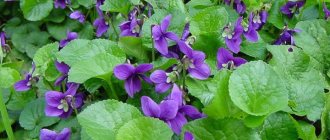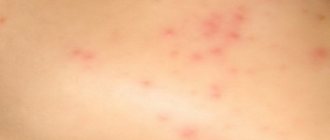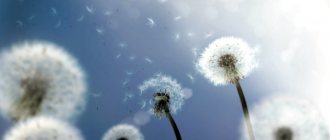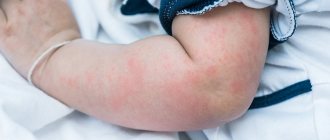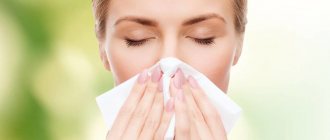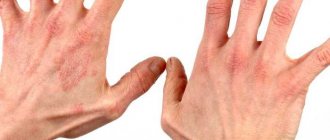When summer ends, many people notice that they have rhinitis, rashes on the body, and attacks of bronchial asthma. This may mean that allergies develop in the fall. If symptoms appear, contact an allergist who conducts laboratory tests and a general examination. Symptomatic therapy is used to relieve the acute process. Some patients agree to pathogenetic treatment using gradual sensitization of the body (see “Effectiveness of using allergen-specific immunotherapy (ASIT) in the treatment of allergies in adults and children“).
Manifestations of September allergies
Allergic diseases are insidious. Often people who do not suspect they have an allergy confuse its symptoms with a common cold - nasal congestion, runny nose, sore throat, sneezing, redness and itching of the eyes.
Difference between allergy symptoms and ARVI:
- The temperature does not rise.
- Nasal discharge is clear.
- Difficulty breathing with wheezing.
- Purulent discharge from the eyes (conjunctivitis)
- Possible rash on the body.
The symptoms do not go away in 3-5 days, like a cold, the general condition worsens without treatment, and secondary signs of allergy are added - headache, irritability, depression.
Symptoms of exacerbation of the disease
Not every patient understands that they suffer from immune hypersensitivity, as the symptoms resemble other disorders. When the first symptoms of allergies appear in the fall, make an appointment with an allergist. He prescribes medication to relieve the exacerbation. To identify which plants you may be allergic to in the fall, tests are carried out in the winter (see in more detail “Tests for allergies necessary to make an accurate diagnosis”).
In children
Allergies in children become more acute in the fall. But more often it is formed only at the local level, since the immune system is not developed enough. Allergies in October and other months of autumn are manifested by the following symptoms:
- runny nose with copious mucus, sneezing, difficulty in nasal breathing due to severe swelling;
- conjunctivitis with severe redness of the eyes, increased production of tear fluid, negative reaction to light;
- skin rash, itching, burning, peeling;
- respiratory pathologies with cough, swelling of the throat.

The doctor reveals what blooms during this period. Further studies will be carried out in winter, when there is no hypersensitivity. In addition to local pathologies, children may experience bronchial asthma (see “Bronchial asthma in a child: how to prevent the disease from becoming chronic?”). During this period it is less strong than in adults. Attacks of suffocation occur at any time of the day, as they occur under the influence of an allergen.
In adults
Often childhood allergic pathology gradually ends. If this does not happen, it persists into adulthood, but can develop into severe systemic pathologies:
- Quincke's edema;
- anaphylactic shock;
- severe bronchial asthma;
- hives.
Local symptoms are identical to those in children, but cross-reactions may gradually develop. For example, if a person is allergic to birch in the fall, they develop hypersensitivity to ragweed. Therefore, allergists advise studying the cross-reaction table to eliminate the risk of sudden onset of allergies. It can also start with food and medicine. The patient should be careful, especially in early autumn when everything is in bloom.
Allergy provocateurs in September
The cause of allergies in September are wind-pollinated plants ; their pollen is light and on dry, windy days can move freely over considerable distances. The concentration of pollen in the air decreases after rain.
A fairly common phenomenon is an allergy to not one, but several plants. Also, with hypersensitivity to pollen, an atypical food reaction can develop, the so-called cross allergy - to foods that are similar in structure.
What plants cause hay fever in September and what products are cross-allergic to?
- Wormwood is a strong allergen itself and causes many cross-reactions - to sunflower oil (also to seeds and halva), potatoes (raw), citrus fruits, honey, dill, celery, tomatoes
- Quinoa - for beets and spinach
- Ambrosia - for sunflower oil, melon, banana, cucumber
- Sunflower - for sunflower oil, seeds, halva
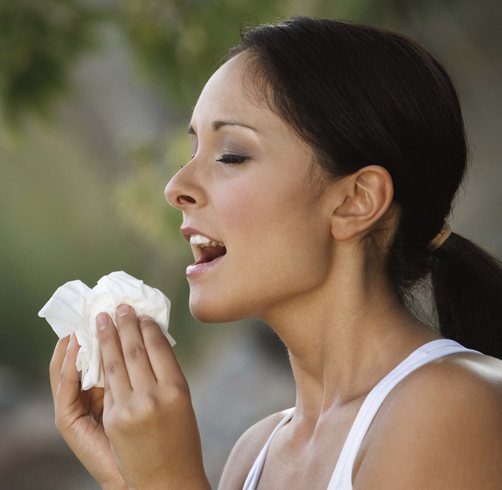
What allergens can cause an exacerbation of an allergy sufferer’s disease in the autumn?
Many people think that immune hypersensitivity occurs in spring and summer due to flowering. But allergies often occur in a child or adult in the fall. It is necessary to identify the plant that causes rhinitis, respiratory pathology, and skin manifestations. The main stage of treatment is eliminating contact with the allergen.
Plant pollen
During flowering, pollen is carried through the air, spreading to the human respiratory system. He inhales it, which is why the following types of allergies appear in early autumn:
- rhinitis – increased production of mucus in the nasal passages, accompanied by frequent sneezing;
- bronchospasm, bronchial asthma - narrowing of the lumen of the bronchi with attacks of suffocation;
- Quincke's edema - severe spasm of the larynx with a sudden cessation of breathing, the need for emergency resuscitation and tracheotomy;
- conjunctivitis is an allergic lesion of the conjunctiva of the eyes with severe itching, redness, lacrimation, photophobia (see “Itching and tearing of the eyes with allergies in adults and children”).
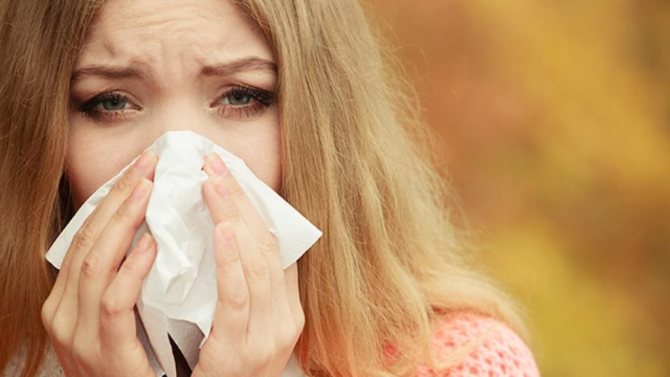
Pollen can be quickly eliminated by rinsing your eyes and nasopharynx.
Molds and bacteria
Exacerbation of allergies in the fall occurs due to the action of molds and bacteria. They are also capable of creating hypersensitivity of the immune system. It is more difficult to fight them; microorganisms are able to penetrate deep into the mucous membrane, spreading into the tissue. Therefore, more serious treatment is required.
Due to pathogenic microorganisms, conjunctivitis, bronchitis, and indigestion develop. Systemic disorders are more dangerous. Angioedema may occur (see “What does urticaria look like in a child: causes, main symptoms and emergency care for sudden development of the disease” and “Causes of urticaria in adults, treatment and preventive measures”). The difference between this type of hypersensitivity is in the treatment. In addition to drugs, antimycotics and antibacterial agents will be required to eliminate sensitization.
Autumn food allergens
Only in the fall do products such as mushrooms, pumpkin, apples, zucchini, beets, cabbage, and turnips appear. They can lead to food allergies in the fall. It is characterized by two types of reactions:
- dyspeptic disorders with nausea, vomiting, diarrhea, abdominal pain;
- skin allergies, accompanied by rash, swelling, redness, itching, peeling.
The antigen spreads rapidly through the intestines and systemic circulation, causing an overreaction of the immune system. If you do not use sorbents in a timely manner, the first symptoms will appear. When a person does not know that he is hypersensitive to a product, he continues to use it. Therefore, signs of seasonal allergies gradually increase in the fall.
House dust and pet hair
House dust is one of the most common antigens that causes immune hypersensitivity. It is mainly manifested by respiratory pathology with frequent sneezing, coughing, and mucus discharge from the nasal passages. Conjunctivitis may occur if there has been direct contact with copious amounts of dust.

Allergies to animal fur occur frequently, especially to members of the cat family. The structure of wool contains a huge number of antigens that quickly cause respiratory pathologies. Small particles in the fur pass through the nasal passages, causing an inflammatory response. The condition is difficult to control; doctors advise not to keep any animal that has fur at home (see also “Hypoallergenic animals for allergy sufferers”).
Negative reaction to cold
Allergies in November are often observed due to the sharp cold snap. Frosts appear even before the onset of winter. Some patients experience a negative skin reaction to cold and low temperatures (see “Allergy to cold”). The epidermis cracks, peels, and areas of hemorrhage appear. The condition is mainly observed on the skin of the hands, but can appear on the feet.
If you are allergic to the cold in the fall, moisturizing creams do not help. Laboratory diagnostics and a general examination by an allergist are required to determine the diagnosis.
Diagnostics
Making a diagnosis of hay fever is not difficult for a doctor. An anamnesis is collected: did any of the patient’s relatives have an allergy (if one of the parents was sick, then the child’s probability of illness is 50%); seasonality of symptoms - their appearance at the same time of year for several years; relief of symptoms in rainy, windless weather (when pollen settles).
A blood test is necessary - allergies are detected by exceeding the normal level of immunoglobulin antibodies.
To accurately determine the triggering irritant, skin tests and tests with diagnostic allergens are performed. These studies are carried out only in winter, during the period of remission of the disease.
Peptic ulcer and gastritis
With the first cold weather, chronic diseases of the digestive tract may worsen: stomach ulcers or gastritis. The condition worsens because the temperature and humidity in the fall are very unstable, the weather changes dramatically. In addition, in the fall, many people face stress and mood changes. All this leads to the fact that the stable functioning of the gastrointestinal tract in patients with chronic diseases is easily upset.
What signs may indicate an exacerbation of a stomach ulcer or gastritis:
- Abdominal pain;
- Heartburn;
- Constant belching after eating;
- Nausea and vomiting;
- Loss of appetite;
- Problems with stool, etc.
If, with the onset of autumn, discomfort and pain in the stomach area appear, this is a reason to see a specialist and, if necessary, undergo an examination. The sooner an exacerbation is diagnosed, the faster your doctor can help you.
To stabilize the gastrointestinal tract during seasonal exacerbation of diseases, the gastroenterologist will prescribe appropriate treatment:
- Antibacterial therapy if chronic inflammation of the stomach is caused by Helicobacter Pylori, a pathogenic microorganism. It is detected, for example, using a breath test.
- Medicines that alleviate the condition during exacerbation of gastritis or ulcers and help establish comfortable digestion.
- A special gentle diet. During the treatment of stomach diseases, the diet consists only of healthy, neutral foods. All “irritants”, including spices, spicy, fatty, fried foods, should be excluded.
Sometimes problems with the gastrointestinal tract are triggered by stress. In this case, you may need to consult other specialized specialists who will help you choose treatment together with a gastroenterologist.
Treatment
Treatment of hay fever is usually outpatient, hospitalization is required only in particularly severe cases. An allergist-immunologist prescribes antihistamines that reduce sensitivity to the allergen. Antihistamines are used for general action - tablets, and local - nasal sprays and eye drops.
In case of too severe symptoms, in advanced cases, and also if antihistamines are ineffective, the doctor selects hormonal drugs - corticosteroids.
Immunoprophylaxis for hay fever is effective - the patient is given a course of subcutaneous injections of the allergen, starting with small doses and gradually increasing the dosage. This method significantly reduces hypersensitivity to a specific irritant; the body will no longer consider it foreign.
Traditional methods of treatment should be used only with the approval of a doctor and only as an auxiliary option; they may not only be ineffective, but also cause harm - herbal decoctions themselves can cause allergies. Therefore, this treatment method should be treated with caution.
Allergy Day
Traditionally, in many countries, including Russia, October 16 is celebrated as World Allergy Day, approved by the World Health Organization.
On this day, educational and educational events on the prevention, diagnosis and treatment of allergies are organized in many cities of our country. On this day, examinations for allergies (allergy tests, prick tests, blood tests) are often organized for the population, consultations with allergists, and open lectures.
Prevention
The ideal option for preventing hay fever is to avoid contact with the allergen during the period of plant dusting. Take a vacation in September and go to a different climatic region, to the mountains or to the sea. But this is not always possible, so you need to know prevention methods to ease the course of allergies:
- Minimize walks in dry, windy weather, take a shower after walks
- Cover the windows with damp gauze
- Use an air purifier and humidifier, carry out wet cleaning in the apartment more often
- Limit contact with household chemicals and perfumes
- Rinse your nose with a saline solution or pharmaceutical products containing sea water
- Eliminate cross-allergens from your diet, as well as honey, chocolate, citrus fruits and spices.
Allergy calendar: what triggers it and in what month
The New Year is coming soon, and for those who suffer from allergies, it is important to find out - are you ready for your personal “season” of this problem? We tell you how to meet it fully armed. The first step in preparation is to visit an allergist and identify your allergies and run tests to find out what causes them.
Tests are carried out without an exacerbation, especially if we are talking about classic hay fever (pollen allergy). Once you know what triggers your symptoms, you can reduce or avoid your exposure, no matter what time of year it is.
But to help you combat unpleasant and sometimes dangerous symptoms, we will discuss which allergens are most relevant in children and adults in a given month.
Allergy options
There are seasonal allergies, where all symptoms occur at a certain time of the year, and year-round allergies, which can occur at any time. It is important to assess which substances and when, in what month or season, provoke your sneezing, itchy skin and wheezing, asthma or other symptoms.
If you suffer from allergies for at least part of the year, it's important to know when you'll finally get relief. People with spring, fall or winter allergies may experience relief during the off-season, but for those who experience allergy symptoms year-round, it's a constant battle with allergens in the air.
It is important to know “your” season in order to visit a doctor in advance and begin preventive treatment. If allergens are dangerous all year round, you need to achieve stable remission and carry out treatment (ASIT or immunotherapy), which will allow you to get rid of allergies for several years.
We wrote more about the development of allergies here.
January allergens
If you live in Russia, by the beginning of the new year, pollen allergies, as a rule, do not manifest themselves. There is snow and frost outside, there are no flowering plants, herbs or bushes, and the body can take a break. However, if the cause of your allergy is dust mites, then the allergy may intensify and develop into full force.
This is due to the fact that we spend a lot of time indoors, the air is dried out by radiators, and the rooms are rarely ventilated. To minimize mites and household dust, use a vacuum cleaner with a HEPA filter, change your furnace filter regularly, new bedding twice a week, and cover your mattress and pillows with anti-allergen covers.
If that doesn't work, get a full, professional deep cleaning.
February allergens
For most regions of Russia, this month is similar to January, with the exception of the south, where by the end of the month, with warming, the first plants may appear.
In addition, food allergens (they act year-round), dust and animal dander, and medications may be relevant at this time of year.
It’s time for allergy sufferers to see a doctor and start preparing for the pollen season by stocking up on medications and taking preventive courses of treatment with hormonal nasal sprays and antihistamines.
Allergens of March
In the southern regions of our country, by March, nature gradually wakes up, the snow melts and precipitation stops, the ground dries out, and due to the wind, dust allergies and reactions to mold, which is abundant in last year’s rotten leaves and grass, are possible. In addition, the first dandelion plants and weeds begin to bloom, and they can provoke allergies. In the middle zone and northern regions, household and food allergens and house dust do not lose their relevance.
Allergens of April
April rains, especially in the south and Volga region, cause serious seasonal allergies. Welcome to peak mold and hay fever! Trees, mold and grass pollen join forces in April to make life miserable for allergy sufferers. For residents of the middle zone and northern latitudes, the time has come to visit a doctor and begin a preventive course of treatment.
Allergens of May
In most regions of the country, pollen from trees, shrubs and cultivated plants is most relevant this month. In addition, the first blood-sucking and stinging insects appear, so the risk of insect allergies also increases - to mosquito bites, venoms of bees, wasps and other insects.
Allergens of June
Even though the trees have finished blooming, flowers and grasses are still going strong, and summer showers can increase mold levels. If you've been complaining about a summer cold for weeks, you likely have allergies and it may be time to see a specialist.
Allergens of July
Good news! By July, the pollen of shrubs and trees recedes, but hot days and wind are carriers for mold spores and weeds, as well as cultivated cereals. To make matters worse, the country's air quality plummets by July.
Summer air pollution and ozone clouds can make your symptoms worse. Try to limit your time outdoors when pollutants and allergen concentrations are particularly high.
Relief can come from rain and watering the lawns around the house, as well as using air conditioning instead of open windows.
Allergens of August
Mold is still a big deal, but in August a new allergen is in the spotlight: weeds like quinoa and ragweed. These are flowering plants growing in trash cans, vacant lots, lawns, and near river banks.
They become the main cause of allergies, with three quarters of all allergy sufferers reporting an exacerbation in August-September. The Southeast tends to be the first to experience ragweed pollen season, as it thrives in its hot, humid climate.
By the end of August, ragweed is rapidly expanding its territory to the north and west, and its allergy sufferers throughout the country will feel itchy and watery.
Allergens of September
Ambrosia, ambrosia and more ambrosia! At this point, if you are suffering severely from hay fever, it is time to consult a specialist. Excessive use of nasal decongestant sprays can cause “withdrawal and addiction syndrome,” which can lead to complications.
Essentially, after a few days, the blood vessels in your nose that reacted to the aerosol by constricting begin to “demand” a new dose of the aerosol and swell even more, awaiting the next dose. Avoid using spray, allergy medications without your doctor's advice.
Allergens of October
If you live in the north, October is usually a good time to get out and enjoy the fresh air. For those of us who live a little further south, fall showers bring mold back to the list of dangerous allergens, but pollen allergies are finally abating.
November allergens
This month you are probably starting to feel some relief. Street allergens have virtually no effect on your condition, but household allergies are becoming relevant again.
Allergens of December
Luckily, freezing winter temperatures should bring complete relief from pollen. But if you celebrate the New Year with freshly cut spruce or pine in your house, you may encounter allergies to pollen and mold, since there is a lot of it on the needles of the forest beauty. In warm weather, allergens will begin to enter the air.
Therefore, for allergy sufferers, an artificial Christmas tree is the best option. But it is also dangerous if stored in a dusty attic or mezzanine. Before putting up the Christmas tree, take it out onto the balcony: dust mites will freeze and die.
Carpets that are laid in the house for warmth are also dangerous for you: it’s time to take them out into the snow and beat them thoroughly, and also let them freeze well.
How is an allergic reaction diagnosed?
Blood tests
If you suspect an autumn allergy, a person will definitely need to visit a doctor. In a medical facility, the patient may need to undergo allergy tests or blood tests to identify the allergen. During allergy tests, a microdose of the allergen that is suspected in this case is applied to the skin of the forearm. If you have an allergy, characteristic symptoms will appear at the site of application of the irritant within 15–20 minutes. In some cases, an analysis to determine the allergen in the blood is indicated. After laboratory testing, not only existing irritants can be detected. You can even identify a reaction that has not yet manifested itself. Only after identifying the irritant and the nature of the reaction will the doctor be able to prescribe treatment. In addition to an allergist, a person is recommended to visit an immunologist. It will help restore the body's protective functions.
allergiyainfo.ru
Prevention and effective treatment of allergies in autumn
For seasonal allergic reactions, the best treatment is antihistamines. You cannot select them on your own, since all medications may have their own contraindications.
It is better to consult a doctor, he will be able to choose the right drug and prescribe a course of treatment, which will quickly help get rid of allergies in October or another specific month.
The following preventive measures will help ease the course of the disease:
By following these simple rules, you can significantly alleviate or completely eliminate allergic seasonal manifestations.
medicala.ru
Symptoms of autumn allergies.
Allergic rhinitis or hay fever occurs due to the ingestion of pollen from ragweed or other flowering plants, as well as mold. As a result, the patient acquires: • Runny nose; • Tear secretion; • Cough; • Itching of eyes and nose; • Dark circles under the eyes.
An allergy to ragweed can cause itching in the mouth and throat in its “victims,” the so-called allergic syndrome. A similar symptom occurs after eating bananas, cucumbers, melons and other vegetables and fruits.
Allergens that are carried through the air can cause asthmatic symptoms, including narrowing of the airways, resulting in difficulty breathing, coughing, runny nose and shortness of breath.
Food allergies become a real nightmare for the patient. He suffers from colic, nausea, vomiting, diarrhea and cough. An acute allergic reaction or anaphylactic shock causes swelling of the lips, tongue and throat, leading to difficulty breathing and the person may simply suffocate.
Causes
The manifestation of certain symptoms and an atypical response of the body to a foreign agent is associated with the characteristics of the human immune system.
When an allergen enters the respiratory system, it tries to get rid of it as quickly as possible, releasing a large amount of histamine into the blood.
This is where typical symptoms appear.
Allergies in the fall most often occur from the following plants:
From the list it becomes clear that avoiding all these allergens is not so easy.

